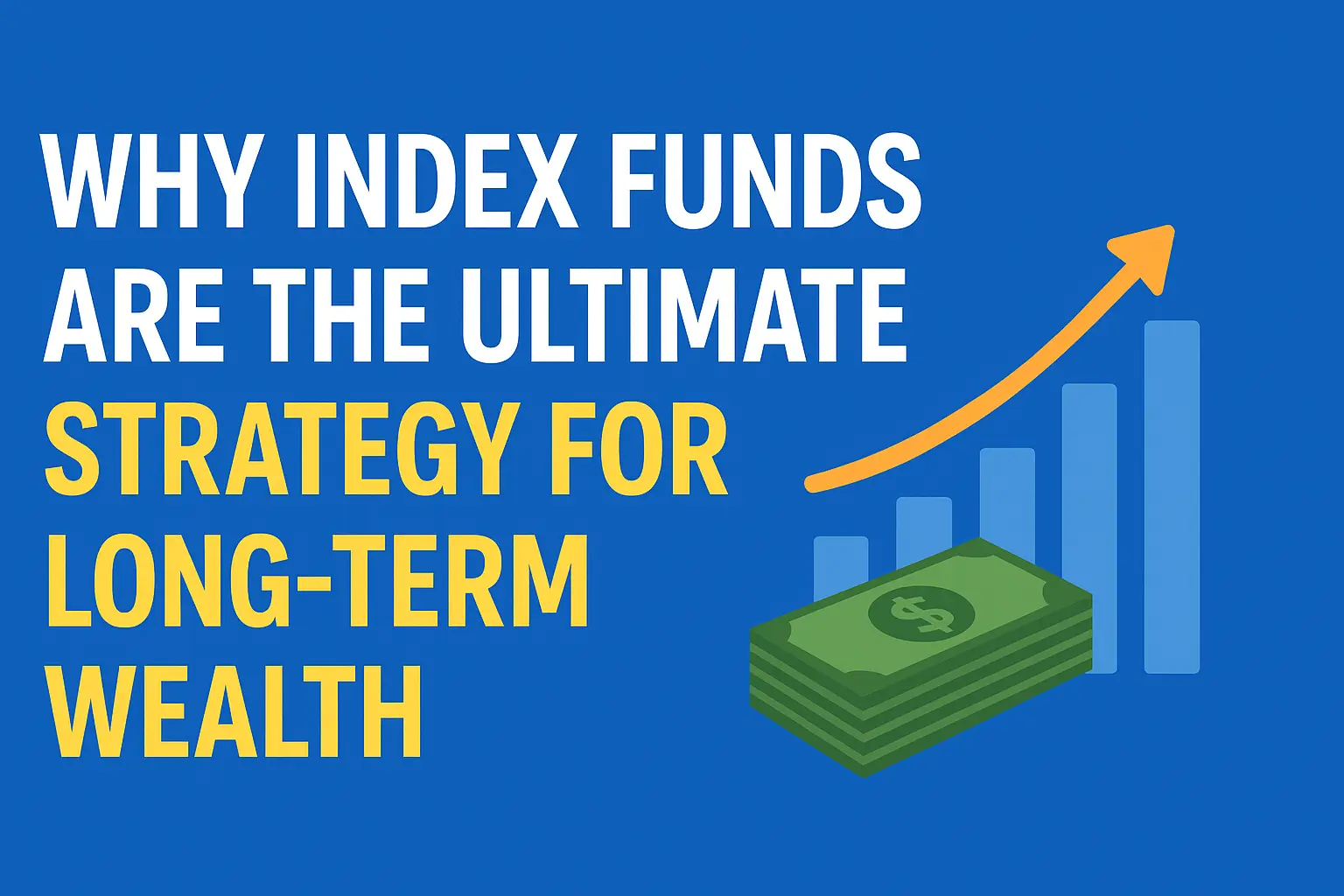Want to know an easy, dependable way to earn money without any hazy stock market jargon?
Index funds provide the average investor an almost automated route to wealth creation, which even buff Warren Buffett can vouch for. In this guide for the beginner-intermediate investor, we will see how index funds regularly beat actively managed investments, go through the timeline of compound growth and wealth creation in real-life examples, and, finally, move into how one can begin their own index fund portfolio.
What Are Index Funds?: Your Way to Steady Growth
How Index Funds Work: The Easy Investment Method
Instead of picking winners, imagine buying a minute share of every company in a market. That’s an index fund in a nutshell.
Index funds are like buying the whole pizza instead of arguing over which slice might taste best. They simply track established market indexes like the S&P 500, which includes 500 of America’s largest companies. When you invest $1,000 in an S&P 500 index fund, you automatically own a small piece of Apple, Microsoft, Amazon, and 497 other companies.
The beauty is in the simplicity. The fund manager isn’t staying up late researching companies or making predictions. They’re just matching the index, which keeps costs incredibly low.
Here’s what happens when you buy in:
- Your money gets spread across all companies in the index.
- When the market is up 10%, your investment is also up by about 10%.
- You receive dividends from every single company in this fund.
- You will pay very low fees as they do not hire an expensive research team.
That’s basically it. No trouble, no dramas; plain vanilla easy investing.
Why Passive Beats Active: The Performance Evidence?
The numbers don’t lie, and they’re pretty embarrassing for active fund managers.
Approximately 15 years ago, and even up to now, around 90% of active managers failed to beat their benchmark indexes. Imagine that. These are professionals with high-paying credentials and with access to advanced research tools yet are incapable of performing better than a simple index fund on a consistent basis.
Why Markets are actually fairly efficient?
The information flows quickly, and price changes occur very quickly. Plus, active managers charge higher fees that eat into returns. Even if they pick some winners, those extra costs often wipe out any advantage.
Look at these sobering stats:
| Time Period | % of Active Funds Underperforming the S&P 500 |
|---|---|
| 1 Year | 68% |
| 5 Years | 78% |
| 10 Years | 86% |
| 15 Years | 91% |
The longer the timeframe, the worse active funds perform. This isn’t a fluke – it’s a persistent pattern across decades.
Low-Cost Advantage: How Fee Savings Compound Over Time
The fee difference between active and index funds might seem tiny, but it’s actually a wealth-destroyer in disguise. Active funds typically charge 1-1.5% annually, while many index funds charge under 0.1%. That difference of just 1% might sound like nothing, but compound it over decades, and you’re talking serious money.
On a $100,000 investment over 30 years with 7% annual returns:
- Index fund (0.1% fee): Grows to about $750,000
- Active fund (1.1% fee): Grows to about $550,000
That’s $200,000 of your money gone – enough to fund several years of retirement or pay for a child’s college education.
Diversification Benefits: Protection Against Single-Stock Disasters
Putting all your eggs in one basket is a recipe for disaster in investing. Even giant companies can implode. Remember Enron? General Electric? Their stocks collapsed, devastating investors who were overexposed.
Index funds instantly spread your risk across hundreds or thousands of companies. If one company tanks, it barely dents your portfolio. When Lehman Brothers vanished in 2008, S&P 500 index-fund investors barely noticed its specific impact amid the broader market decline.
This diversification works across industries too. During the dot-com crash, tech stocks plummeted; in contrast, healthcare and utility stocks held up better. With an index fund, you are always invested across all sectors, providing a natural cushion against the collapse of any one industry.
The Math Behind Index Fund Success

The Power of Compound Returns in Index Investing
Numbers don’t lie, and the math behind index fund success is downright fascinating. When you invest in index funds, compound returns become your best friend.
Think of compound returns like a snowball rolling downhill. Start with $10,000 in a simple S&P 500 index fund. At the historical average return of about 10% annually (before inflation), your money doubles roughly every 7 years. After 30 years? Your initial investment grows to over $174,000 without adding another penny.
But it gets better. Most people don’t just invest once. They add money regularly. If you put in $500 monthly to that same index fund, after 30 years you’re looking at around $986,000. All from simply tracking the market!
The real magic happens in the later years. In the first decade, your returns might seem modest. But in years 20-30, your money starts growing by thousands each month, even on days you don’t check your portfolio.
How Market Average Returns Outperform Most Active Managers
The shocking truth? About 90% of active fund managers fail to beat the market over a 15-year period. This isn’t just bad luck—it’s mathematical reality.
Active managers face an uphill battle for three main reasons:
- The market itself represents the collective performance of all investors.
- Higher fees eat into returns year after year.
- Timing mistakes compound over time.
When an index fund simply tracks the market, it captures the entire market’s growth. Meanwhile, active managers must outperform significantly just to cover their higher fees.
Here’s how dramatic the difference becomes:
| Time Period | $10,000 in Index Fund (7% return) | $10,000 in Active Fund (5.5% return after fees) | Difference |
|---|---|---|---|
| 10 Years | $19,672 | $17,098 | $2,574 |
| 20 Years | $38,697 | $29,220 | $9,477 |
| 30 Years | $76,123 | $49,937 | $26,186 |
Transaction Cost Minimization: A Hidden Wealth Builder
Transaction costs are the silent wealth killers most investors ignore. Index funds destroy the competition here.
Companies tend to run from 60 to 100% turnover rates yearly, or so they claim. So, every dealings come with costs: commissions, bid-ask spreads, and tax ramifications. These easily add 0.5-1% in hidden costs beyond the expense ratio.
Index funds? They might have turnover of just 2-3% yearly. The S&P 500 rarely changes its companies, so index funds barely need to trade.
These savings compound dramatically. Accordingly, 1 percent less annual return due to costs means $1.26 more after thirty years.
Transaction costs also confer a tax advantage. Because index funds do less active trading, there are fewer capital gains distributions to be received upon which you can make tax payments, thereby maximizing the tax sheltering of your gains. This effect of tax efficiency adds 0.5 or 1 percent to your effective rate of return.
So the math is quite clear. Index funds win not through flashy strategy but simply because of the unremitting discipline of trying to reduce costs while tracking market returns.
Real-World Wealth-Building-Assisted Index Fund Application

Millionaire Case Studies: Ordinary People, Extraordinary Results
Sarah was a school teacher from Ohio, and she never made more than $55,000 a year. For 28 years, she contributed to an S&P 500 low-cost indexed fund consistent with 15 percent of her salary, earning herself $1.2 million, no trading tricks, no market timing, just steady deposits and patient waiting.
Another example is David, the UPS driver, who put $100 in his 20s monthly toward a total-market-index fund. As his salary increased, he gradually increased contributions to building a $1.7 million portfolio at 59. The key was to ignore the market crashes of 2008 and 2020. The world’s greatest investor betting against professional money managers and FOR index funds speaks volumes.
“The trick is not to pick the right company,” Buffett later explained. “The trick is to essentially buy all the companies through the S&P 500 and to do it consistently.”
Building Wealth. Anyhow of request Timing.
The stock request has historically delivered around 10 periodic returns before affectation. But timing the request? Nearly insolvable.
Still, 000 in the S&P 500 on January 1, 2000(right before the stock- com crash), If you invested 10. Have over 32,000 moment despite hitting the worst possible timing.
Indeed, more? Dollar-cost averaging through indicator finances turns request drops from disasters into openings. When prices fall, your regular dividends buy further shares, setting you up for bigger earnings when requests recover.
Tax Efficiency: Keeping further of Your Returns
Indicator finances are duty machines. Because they infrequently turn over their effects, they induce smaller capital earnings distributions than laboriously managed finances.
A Morningstar study set up the average laboriously managed fund lost 1.3 annually to levies, while indicator finances lost just 0.4%. Over 30 years on a 100,000 investment, that is about 137,000 in redundant plutocrat in your fund.
Retirement Security How Index finances produce Sustainable Income
The 4 rule – withdrawing 4 of your portfolio annually – works beautifully with indicator finances. A 1 million indicator fund portfolios can induced 40,000 in first-time withdrawal income with high probability of lasting years.
More yet, indicator finances give you instant diversification. A single total request fund might hold 3,500 companies across every sector. This diversification means you are no way overused to any single company’s failure.
And when withdrawal arrives? You can shift gradationally from growth-concentrated to tip- concentrated indicator finances, creating income avenues without dealing with your core means during request downturns.
Enforcing Your Index Fund Strategy

Getting Started Minimum Investments and Account Types
Getting your indicator fund trip off the ground is unexpectedly simple. Utmost major brokerages like Vanguard, Fidelity, and Charles Schwab have dramatically lowered their walls to entry.
Back in the day, you demanded $3,000 or more to buy into an indicator fund. Now? Numerous finances will let you start with just 1. No joke. Fidelity indeed offers zero minimum investment conditions on numerous of their indicator finances.
Your account type matters too. Then is a quick breakdown:
- 401(k): If your employer offers indicator finances then, jump on it! Free plutocrat from employer matches is a no-brainer.
- IRA/ Roth IRA: Perfect for duty advantages with 6,000 periodic donation limits ($ 7,000 if you are over 50).
- Taxable brokerage accounts: No donation limits but no duty benefits moreover. Great for plutocrats you might need before withdrawal.
Numerous people do not realize you can open these accounts in about 10 twinkles online. Utmost brokerages have slick mobile apps too, making it dead simple to cover your investments.
Choosing Between Different Index Funds
Not all indicator finances are created equal, and the differences can seriously impact your returns over decades.
The expenditure rate is your first consideration. This bity chance (immaculately under 0.1) gets taken out of your returns annually. Small difference? Suppose again. A 0.5 versus 0.05 expenditure rate can bring you knockouts of thousands over 30 years.
Here’s what to look for in different indicator fund orders:
The tracking error is another consideration most newcomers miss. Some finances drift from their standard indicators further than others. Lower tracking error means the fund actually delivers what it promises.
Asset Allocation Balancing Stock and Bond Index finances
The classic investment question: How important are stocks vs. bonds? Your answer shapes everything.
A dead-simple starting point is the “120 minus your age” rule. That is the chance you put in stocks. So if you are 30, about 90 stocks and 10 bonds. This automatically becomes more conservative as you age.
But that is just a starting point. Threat forbearance varies hectically between people. I know 60- time-pasts with 90 stocks and 30- time-pasts who sleep better with 60/40 portfolios.
Some considerations:
- Advanced stock allocation = further growth eventuality but bigger swings
- Advanced bond allocation = more stability but potentially lower returns.
- Your time horizon matters further than your age.
Dollar-Cost Averaging Maximizing Long-Term Results
Trying to time the request is a fool’s game. Indeed, the pros get it wrong constantly.
Dollar-cost averaging is the cure. Invest the same quantum at regular intervals — weekly, yearly, whatever works for your cash inflow. When the request is down, you buy further shares. When it is over, you buy smaller.
This approach is not just financially sound; it is mentally liberating. Request drops come openings rather than reasons to horrify. You are basically buying indicators finances” on trade” during downturns.
The stylish presentation automates it fully. Set up automatic transfers from your checking account to your investment account. Also forget about it. Seriously. Check your portfolio daily at least.
Overcoming Common Index Fund Misconceptions

Index Funds Are Too Boring”: Excitement vs. Results
Whenever I tell people about index funds, I often get the same reaction: a polite yawn.
“Index funds? Sounds like watching paint dry.”
But here’s the thing – boring makes money. While your day-trader friend brags about that one stock that doubled last month (conveniently forgetting to mention the five that tanked), index fund investors quietly build wealth.
The financial media thrives on excitement. “5 Hot Stocks That Could Explode Tomorrow!” gets clicks. “Continue Your Regular Index Fund Contributions” doesn’t exactly make for breaking news.
But check this out:
| Investment Approach | Emotional Appeal | Typical Long-Term Results |
| Stock Picking | High | Underperforms indexes |
| Day Trading | Very High | 95% lose money |
| Index Funds | Low | Market returns with minimal effort |
Wall Street makes money when you trade frequently. They don’t profit much when you buy and hold index funds. No wonder they want you to think index investing is for unambitious losers.
“You Can’t Beat the Market”: Why That’s Actually Good News
“You can’t beat the market with index funds” isn’t an insult – it’s the whole point.
The brutal truth? About 90% of professional fund managers fail to outperform their benchmark indexes over 15+ years. These are experts with Bloomberg terminals, research teams, and expensive degrees.
If the pros can’t consistently beat the market, what chance do we have?
Index funds flip this problem into an opportunity. Instead of trying to beat the market (and likely failing), you simply become the market. You’re essentially saying, “I’ll take the average return of all investors.”
And that’s actually pretty fantastic when you consider that the S&P 500 has historically returned about 10% annually over the long term.
Surviving Market Downturns With Index Funds
Market crashes aren’t just possible – they’re guaranteed. The beauty of index funds is that they’re built for survival.
When markets tank, individual companies can go bankrupt. But broad market indexes? They simply replace failing companies with rising stars. The index evolves.
During the 2008 financial crisis, many supposedly “safe” stocks collapsed or disappeared entirely. Meanwhile, index fund holders certainly felt pain, but their diversification meant no single company failure could destroy their portfolio.
The recovery phase is where index funds really shine. By staying invested through the crash (rather than panic-selling), index investors automatically caught the entire rebound.
The Psychological Advantage: Set It and Forget It
The biggest investing enemy isn’t market crashes or inflation – it’s your own brain.
We’re wired all wrong for investing. We get greedy when markets soar and panicky when they drop – the exact opposite of “buy low, sell high.”
Index funds provide a psychological shield. With a simple automatic investment plan, you can essentially put your wealth-building on autopilot.
No more stressing over picking winners. No second-guessing yourself during a few days of wobbles at the markets. No FOMO while your colleague bragged about their crypto profits.
This psychological liberty could probably be the biggest advantage of index investing. Your thoughts can now move towards career, relationships, wild hobbies, you know, life itself.
Conclusion
Building lasting wealth doesn’t imply complicated investment strategy or scrambling to keep up with the markets. Index funds represent a potential pipeline leading to wealth by means of diversification, less cost, and time-tested good return. The mathematics clearly explain how and why most active managers failed to beat their benchmark indices; hence logically speaking, index funds become the offer for an investor willing to grow reasonably along with consistent returns.
Is it about time to go on your wealth-building trip? Start now by making small, regular contributions to a broad market index fund, increasing your contributions over time as your earning increases. Be reminded that market volatility is normal—look beyond volatility all the way to long-term goals. By embracing index funds on terms of your investment strategy, you are really heralding simple ways to achieve financial success.
